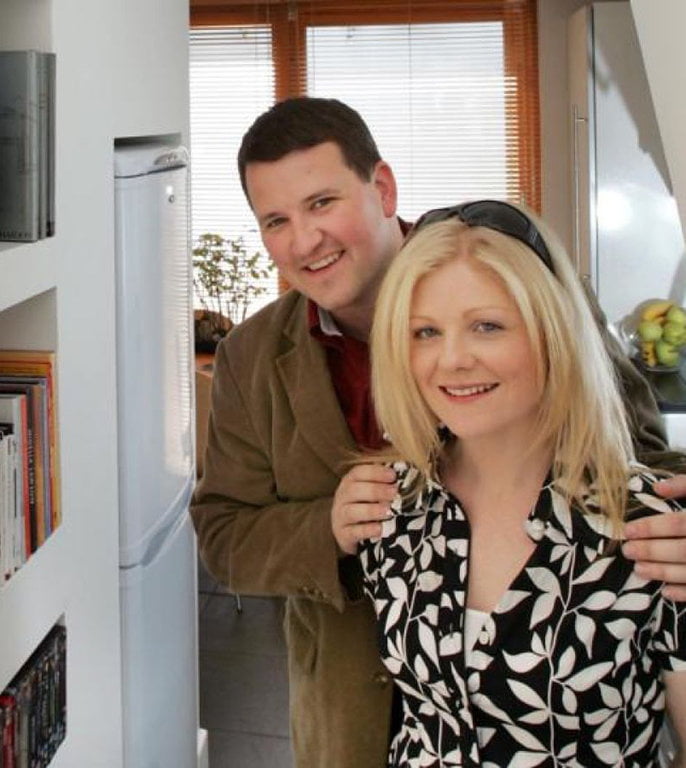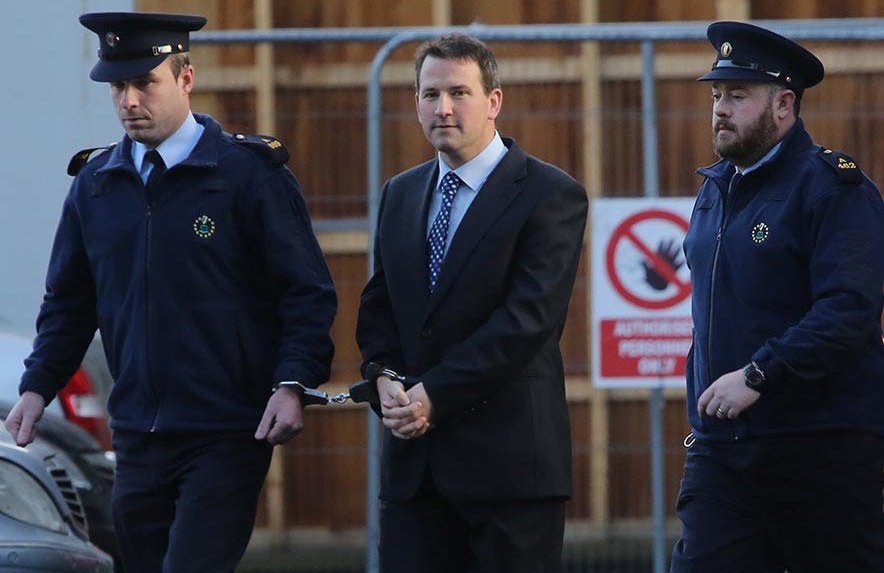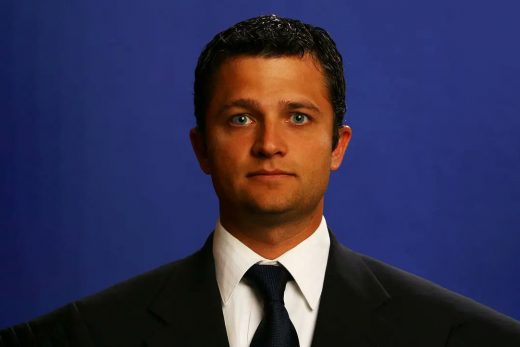Graham Dwyer, 51, is a notorious Irish killer, born in 1972 to his parents Sean and Susan Dwyer. Dwyer is a middle child of four children, including his Sister Mandy, and two younger brothers, Brendan and James.
Graham is romantically involved with two women one of his first Girlfriend Emer McShea with whom he had one son named Sennan who is now 31 years old. However, later Dwyer marries another woman named Gemma Healy.
Graham Dwyer’s Early Life
Graham Dwyer was born on September 13, 1972, in Bandon, a small town in County Cork, Ireland. He was the middle child in a family of four children – an older sister named Mandy and two younger brothers, Brendan and James. His parents were Sean and Susan Dwyer.

Dwyer spent the majority of his childhood years with his family in Bandon. He attended the primary school in Crossmahon, just outside of Bandon. As a teenager, Dwyer had an interest in music. He learned to play the bass guitar and was part of a local band called Strangeways. Amongst his peers, Dwyer gained notoriety as a musician and was popular among young women in the area.
After finishing secondary school, Dwyer left his hometown of Bandon in the early 1990s to pursue higher education in Dublin. He enrolled in an architecture program at the Dublin Institute of Technology, Bolton Street campus.
Graham Dwyer’s Relationship with Emer McShea
In the summer of 1991, a 19-year-old Graham Dwyer met Donegal woman Emer McShea at a music festival in Tipperary.
The two young lovers quickly became serious, resulting in a pregnancy not long after they first met. McShea gave birth to their son Sennan in October 1992. Dwyer split time between raising his new infant son and continuing his college studies in Dublin.
Also Read: Brenda Dupont, 29, R*ped and Stabbed 31 Times by Joenell Rubin, Sentenced to Life in Prison
McShea would later testify in court to violent fantasies Dwyer shared with her in their intimate moments. According to her testimony, Dwyer confessed that he fantasized about stabbing women during sex. He even began bringing a kitchen knife into their bedroom and pretending to stab McShea mid-intercourse.
By 1996, Dwyer’s volatility, temper, and violent sexual urges drove McShea to leave with four-year-old Sennan. Fearing for her and her son’s safety, McShea moved back to Donegal, severing ties with the disturbed architect-in-training.
Marriage Life with Gemma Healy
In 1997, Graham Dwyer met architecture student Gemma Healy while they both studied at the Dublin Institute of Technology.
The couple wed in 2002 at the picturesque Sligo Cathedral. Her father, Dr. John Brendan Healy, worked as an orthopedic physician.
The couple enjoyed passions like architecture, cars, computers, and model airplanes. They set up home together, even renovating an artisan cottage in trendy Dublin 6 which got coverage in The Irish Times’ Home & Design section. In 2000, a then 28-year-old Dwyer appeared on the RTE television show “Beyond the Hall Door” showing off the sleek bathroom he had designed.

According to later courtroom testimony from Gemma, her husband loved expensive cars like his Porsche 911 which he affectionately referred to as his “baby.” At the time police arrested him in connection to Elaine O’Hara’s murder, Dwyer owned two late model luxury vehicles – a Land Rover Discovery jeep and an Audi.
By 2013, Dwyer catastrophically unleashed his darkest urges in the brutal murder of Elaine O’Hara, destroying his family in the process.
In the subsequent trial, Gemma Healy Dwyer testified against her estranged husband. The testimony proved damning, outlining in gruesome detail the extent of his sexual violence and murderous fantasies.
Since his life sentence began in October 2013, Dwyer remains cut off from the wife and family life he once held so dear.
Graham Dwyer Career
As a young man he played bass guitar in a local band called Strangeways. Among the small town’s youth, Dwyer gained notoriety for his musicianship and way with women.
In the early 1990s, Dwyer left behind his musical pastimes to pursue architecture. He studied at the Dublin Institute of Technology. Before even graduating, Dwyer began working in architecture offices to gain practical experience.
Dwyer’s professional prospects steadily improved during the 2000s boom years in Ireland. In 1998, he became an associate member of Ireland’s top architecture organization. By 2001, he had gained full membership status.
Dwyer worked for several firms before landing a job with A&D Wejchert & Partners Architects in 2001. Known as one of Ireland’s leading urban design companies.
Before landing his director role at A&D Wejchert & Partners, Dwyer worked at several distinguished architecture practices including Keane Murphy Duff, Oppermann Associates, and Burke-Kennedy Doyle.
Dwyer enjoyed hobbies befitting his professional status, like flying high-end radio-controlled model aircraft and driving luxury cars.
In June 2006 Dwyer became a director of the company. He contributed to major development projects at home and abroad in Poland.
However, according to information disclosed in police interviews later entered into court testimony, Dwyer struggled with mounting debts and financial strains around the time of Elaine O’Hara’s murder in 2012:
“I was deeply in debt. We had good prospects in 2007. We had a cottage in Rathmines, bought the house in Foxrock to renovate. Then the crash happened. Gemma lost her job and I had huge pay cuts,” he had said.
His trial also exposed the significant pay cuts Dwyer and other directors faced at A&D Wejchert & Partners after the 2008 global crash. By 2011, Dwyer’s salary plunged from a pre-recession high of €140,000 annually to just €70,000 – a 50% decrease overall.
Financial background
During the peak of Ireland’s economic boom in the late 2000s, Graham Dwyer enjoyed a luxurious lifestyle supported by an architect’s salary that likely exceeded €140,000 annually. He had the disposable income to frequently travel to holiday destinations like Lanzarote with his wife and family.
However, when the 2008 global recession hit Ireland, Dwyer felt the financial strains personally and professionally. His employer, A&D Wejchert & Partners Architects, cut director salaries by 50% between 2009-2011.
You may also like: James O’Reilly, Irish R*pist who r*ped 7 daughters and his sister, died in a custody
Dwyer’s salary plunged rapidly to €70,000 annually – a drop of €70,000 in just two years. Furthermore, his wife Gemma lost her job and went through an extended redundancy period while finding new work.
Despite having a pension premium payment of €13,000 made on his behalf in 2011, Dwyer sank deeper into debt leading up to Elaine O’Hara’s murder in the summer of 2012.
Dwyer admitted in police interviews he felt “very poor” and had resorted to selling personal belongings like two bicycles to get by. For his 40th birthday in September 2012, his family and friends could only afford to gift Dwyer a guitar and pool funds for a modest restaurant dinner.
Missing and Searching of Ms. O’Hara
On August 22, 2012, 36-year-old childcare worker Elaine O’Hara mysteriously vanished from her Dublin home without explanation. She left behind her purse, bag and primary mobile phone. Security footage showed O’Hara leaving that day with an alternate mobile device in hand. Suspicions arose about her involvement with the upcoming Tall Ships festival in Dublin, where she often volunteered.
The last credible sighting of Miss O’Hara came from a jogger in Shanganagh Park, not far from Shankhill Cemetery where her late mother was buried. Witnesses placed a woman matching O’Hara’s description at her mother’s gravesite, crying audibly.

Due to O’Hara’s past psychological issues and local geography, investigators assumed she committed suicide by jumping from nearby coastal cliffs. Her abandoned car nearby supported this tragic explanation.
A long hot summer had drastically lowered the water levels of Vartry Reservoir near Roundwood, County Wicklow. Normally 15-20 feet deep near the bridge, the waters shrank to just 12-18 inches in 2013. Every day citizens uncovered handcuffs, clothing, and other restraints floating into the Reservoir. Around the same time, dog walker Magali Vergnet discovered scattered human skeletal remains while walking near Dublin’s Kilakee woods.
Dental records soon identified the partial skeleton as the missing O’Hara. Examining the bones, investigators could only recover approximately 65% of Elaine O’Hara’s skeleton.
What Happened Actually and the Arrest of Dwyer
A major break in the case came when police discovered Elaine O’Hara had an account on the adult fetish website Alt.com under the name “helpmelearn36/F.” Viewing her profile showed O’Hara had accessed another user named “architect72.”
This account used an email, [email protected], that linked back to Graham Dwyer – a practicing architect living not far from where O’Hara was last seen.
Combing through Dwyer’s and O’Hara’s laptops and cloud backups revealed evidence of an intensely violent sexual relationship between the two from 2007-2008. Fragments of emails showed exchanges about bondage, knives, and distressing sexual content.
More: R*pist Stephen Charters, 57, dies in prison after being jailed, what about his wife and family?
The recovered materials included homemade videos depicting rough sexual scenes verging on assault.
In 2011, Dwyer reconnected with O’Hara through burner phones using prepaid SIM cards. Text messages painted a deeply unsettling picture of Dwyer’s state of mind:
“I want to stick my knife in flesh while sexually aroused…I would like to stab a girl to death some time,” wrote Dwyer under the name “Master” to O’Hara’s “Slave” number in June 2011 communications.
Even more disturbing messages emerged:
“My urge to rape, stab or kill is huge. You have to help me control or satisfy it.”
Graham Dwyer’s Arrest
The breadcrumb trail tracked from Elaine O’Hara’s digital footprint led investigators to obtain warrants to search Graham Dwyer’s home. Documents and materials discovered during these raids provided damning connections between Dwyer and the missing O’Hara.
Despite video evidence of Dwyer meeting O’Hara shortly before her disappearance, he initially denied even knowing her when questioned. As more evidence emerged, he changed tactics by outright denying any involvement in the murder.
Dwyer’s murder trial began in January 2015. Over months on the stand, prosecutors laid out a meticulous, premeditated plan by Dwyer to lure O’Hara to her death.

They leveraged Dwyer’s violent homemade videos and chilling text messages as clear desires to rape, stab, or kill a woman. O’Hara’s own messages highlighted how Dwyer mentally manipulated her lack of self-worth and existing mental health issues.
The prosecution contended Dwyer specifically used their sexual relationship riddled with abuse, knives, and threats to hide his true motivations. By hiding phones and evidence after killing O’Hara, Dwyer clearly demonstrated calculated efforts throwing off suspicions and appearing a suicide.
After considering the abundance of digital, physical, video, and textual evidence over months, the jury unanimously found Graham Dwyer guilty of Elaine O’Hara’s murder on 27 March 2015. The judge concurred absolutely with their decision in sentencing Dwyer to life behind bars for 30 years.
Dwyer Appeals Murder Conviction Over Mobile Data Usage
After his unanimous guilty verdict in 2015, Graham Dwyer launched an appeal challenging deficiencies in the prosecution’s argument. His legal team, led by Remy Farrell, contended there was no conclusive evidence tying Dwyer directly to Elaine O’Hara’s death.
They further highlighted O’Hara’s existing depression and recent release from a psychiatric hospital. Given her psychological history hinting at suicide risk, the defense argued insufficient proof existed showing her death as murder rather than self-inflicted.
However, the initial appeal was dismissed in early 2022. Ireland’s Court of Appeal admitted the mobile data evidence while acknowledging it formed a small portion of the wider prosecution case.
Dwyer’s defense then escalated their appeal to the European Court of Justice. Their core argument rested on Irish laws allowing broad digital data gathering by police without sufficient privacy safeguards.
In 2021, an EU legal adviser’s preliminary opinion stated indiscriminate retention of mobile metadata should only be permitted in cases of national security threats – not routine criminal investigations.
Last April, the EU Court ruled Ireland’s “indiscriminate data harvesting” breached European laws. While not a binding verdict on Dwyer specifically, the decision bolstered his team’s case.
As Dwyer’s appeal continues, the Irish government faces pressure to update surveillance laws. But prosecutors emphasize digital evidence formed just a fragment of his overwhelming conviction.






